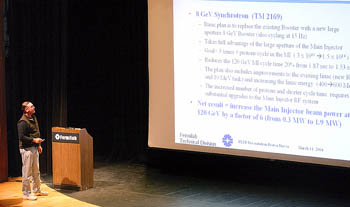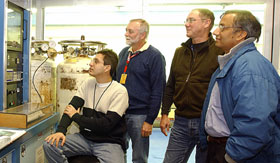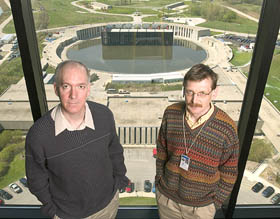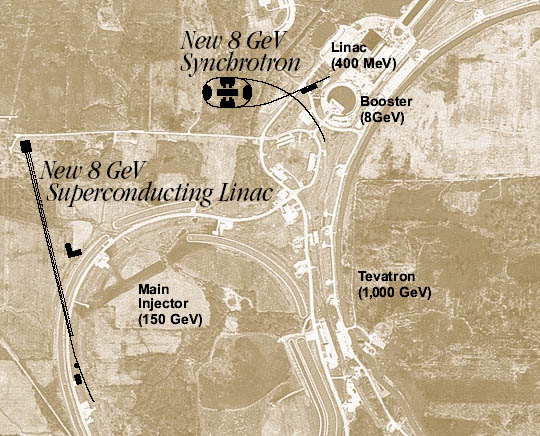|
Fermilab Prepares for its Future
by Kurt Riesselmann
"WHAT WE SEE IS A REVOLUTION"
 | | Bob Kephart chaired the Proton Driver working group of the Long Range Planning Committee. He presented the preliminary results of the group in front of several hundred scientists in Fermilab's
Ramsey Auditorium on March 11. - Photo by Reidar Hahn |
It was an historic moment when several hundred physicists gathered in Fermilab's Ramsey Auditorium on March 11 to consider their response to a revolution. They had come to listen to strategies and recommendations. They asked questions and discussed answers. They weighed the merits of different time lines and the tools to be used. At times emotions were high, as were the stakes: the future scientific program of Fermilab.
In the last five years the worldwide physics community has found signs of revolutionary changes in our understanding of nature. Particle physicists have found that neutrinos have mass and oscillate, causing a huge crack in the 30-year-old "holy grail" of particle theory: the Standard Model of particles and interactions, which predicted massless neutrinos. The mechanism responsible for the masses of all particles is soon expected to make its appearance. Astrophysicists have discovered that 95 percent of the universe is made of dark matter and dark energy, stuff invisible to the naked eye—and physicists so far can only speculate about its origin.These and other observations indicate that there is much more to learn.
 | | Hugh Montgomery, chair of the Fermilab Long Range Planning Committee |
"What we see is a revolution," said Associate Director Hugh Montgomery addressing the crowd. "The Standard Model we feel is beginning to give way to something new. The Tevatron, and certainly the Large Hadron Collider, will pull back the curtain on the origin of mass and electroweak symmetry breaking."
Montgomery chaired the 15-member Fermilab Long Range Planning Committee that has been studying Fermilab's future beyond the LHC, which will begin operations at the European laboratory CERN in 2007. The LRPC, which began its work in the fall of 2003, has been charged by Fermilab Director Michael Witherell "to develop in detail a few realistically achievable options for the Fermilab program in the next decade under each possible outcome for the Linear Collider. The goal in developing each option should be to optimize the opportunities available at Fermilab in this period for high energy physicists to answer the most important questions in our field."
 | | Steve Holmes, deputy chair of the Fermilab LRPC and convenor of the Linear Collider working group, at the LRPC presentation in Ramsey Auditorium |
Fermilab is well suited to be a major player in advancing the revolution. While conducting Collider Run II at the Tevatron, Fermilab has been building the NuMI neutrino beam line and installing the MINOS neutrino detectors. Two months ago, the
Office of Science of the Department of Energy gave Fermilab the first approval, Critical Decision Zero, of the BTeV experiment. Fermilab will also have a central role in an active U.S. research program at the LHC, participating in both the CMS experiment and the development of the LHC accelerator upgrades. In addition, Fermilab is involved in several smaller-scale projects in astrophysics. Altogether, the Laboratory is guaranteed a vibrant research program throughout the end of this decade.
But what will Fermilab be doing in the year 2015? Since it takes years to plan and construct largescale science facilities, it is not too soon to ask the question. The physics revolution is provides plenty of research opportunities, but choosing—and funding—the right path is difficult.
"There are two visions of where the lab can be in 2015," said Associate Director Steve Holmes, deputy chair of the LRPC. "Either there'll be a Linear Collider within 20 miles of the lab, and it would be a big part of the lab's program; or the Linear Collider will not be near, and we would become a world center of excellence in neutrino physics with a high-luminosity proton program. The question is: Given that, what do we do now? The two facilities represent vastly different scales."
 | | R&D for a Linear Collider at the Large Vacuum Furnace in Technical Division building IB4. Shekhar Mishra (right) leads the LC R&D effort at Fermilab, with Technical Division head Bob Kephart (second from right). Tug Arkan (left) and Harry Carter are the lead engineers on x-band LC R&D. - Photo by Reidar Hahn |
The LRPC formed 10 working groups to study the two scenarios and the future scientific program that would accompany these efforts. The subcommittees brought in experts, both from inside the lab and outside, to lay out the issues. After developing a thorough understanding of the issues, the working groups drafted "protorecommendations," which they discussed with scientists from across the lab in a series of open sessions, each drawing more than 100 scientists, with Fermilab's directors listening to the discussions. In January 2004, the LRPC gathered for a 2-day retreat to develop a plan on how Fermilab should proceed in the near future to achieve its long-term goals. Since then the committee has worked on finalizing its report.
"The committee has served as a discussion group to go out and get the information," said Princeton University physicist Peter Meyers, a collaborator on the MiniBooNE experiment and member of the LRPC. "It was our charge to hash out the arguments that will shape Fermilab's future. However, obviously, this committee does not make the final decision."
The meeting on March 11 was the last open session before the committee publishes its
final report in May. The key recommendations, presented by Montgomery at the meeting, are in place:
It is imperative that Fermilab prepare a bid to host the electron-positron linear collider, with broad U.S. linear collider accelerator collaboration. The Fermilab planning should be based upon the host laboratory/international project model.
Fermilab must prepare a conceptual design report for a facility (AKA Proton Driver) that creates high-luminosity proton beams for a Super Neutrino
Beam. The goal is to establish mission need, obtaining Critical Decision Zero (CD-0) approval from the Office of Science.
Members of the Fermilab Long Range Planning Committee:
Hugh Montgomery (Chair)
Fermilab Associate Director
Steve Holmes (Deputy)
Fermilab Associate Director
Joel Butler
Fermilab,
BTeV Collaboration
Marcela Carena
Fermilab,
Theory Department
Gary Feldman
Harvard University,
MINOS Collaboration
Josh Frieman
Fermilab,
Theoretical Astrophysics Department
Steve Geer
Fermilab,
Accelerator Division
Chris Hill
Fermilab,
Theory Department
Bob Kephart
Fermilab,
Technical Division
Young-Kee Kim
University of Chicago,
CDF Collaboration
Peter Meyers
Princeton University,
MiniBooNE Collaboration
Sergei Nagaitsev
Fermilab,
Recycler Department
Angela Olinto
University of Chicago,
Astrophysics and
Astronomy Department
Ritchie Patterson
Cornell University,
CLEO Collaboration
Jim Strait
Fermilab,
US LHC Accelerator Project
John Womersley
Fermilab,
DZero Collaboration
|
The linear collider is a multi-billion-dollar accelerator for the next generation of precision measurements at the energy frontier. Over 2,600 physicists from around the world have signed a document supporting a high-energy electronpositron linear collider as the next major experimental facility for frontier particle
physics research (see story at www.interactions.org/cms/?pid=1011605).
In its 20-year strategic plan of Facilities for the Future of Science, released in December 2003, the Office of Science of the Department of Energy has listed the linear collider as the highest midterm priority. Fermilab currently has a $3 million R&D program for LC technology, collaborating with other laboratories (see FERMINEWS, vol. 27, no. 3, March 2004).
The Super Neutrino Beam is also listed in the 20-year plan of the Office of Science. The beam, many times more intense than those available with current accelerators, would be powered by a megawatt proton driver, a project estimated at about an order of magnitude smaller than the LC. Several laboratories are interested in such a
machine, which would allow scientists to begin precision measurements of neutrino measurements, comparable to measurements of corresponding properties of quarks over the last 40 years.
Some Fermilab scientists expressed concern that the decision-making process of the linear collider, a complex international project with stakeholders in many countries and laboratories, will take the entire Fermilab program "hostage to this process," as pointed out by Stanford University's Stan Wojcicki at the March meeting.
Ensuring that Fermilab remains a valid contender for both projects, the Fermilab Directorate took action with regard to the key recommendations of the LRPC after the March meeting.
"At this time we will pursue both projects, assuming that within a couple of years an assessment and a decision will be made," said Holmes. "The director has issued two charges. Bill Foster and Steve Geer are leading the Super Neutrino Beam efforts, aiming for CD-0 approval and preparing the ground work to go beyond. One aspect of the charge is to get better cost estimates, and understanding the scientific benefits, of implementations based on either a superconducting linac or a more traditional synchrotron. Shekhar Mishra now is coordinating our linear collider accelerator efforts at the lab. His charge is to maximize the possibility that the linear collider will be built with strong Fermilab participation, and preferably as host. The final decision where the linear collider will be built is beyond our control."
 | | Bill Foster (left) and Steve Geer are in charge of the studies for the Proton Driver, which would replace the Fermilab 8-GeV Booster accelerator ring (background). The Booster is the bottleneck in the production of higher-intensity proton beams. - Photo by Reidar Hahn |
This approach allows Fermilab to pursue the timely construction of the proton driver if the linear collider should be built elsewhere or if no decision is in sight.
The Fermilab Directorate will present the Long Range Plan to the Director of the Office of Science, Raymond Orbach, when he visits Fermilab on May 6.
"We see an exciting future for Fermilab," said Montgomery. "If we work together we can make it happen."
Proton Driver for Super Neutrino Beam
The Proton Driver study group is examining two options for creating high-intensity proton beams for the next generation of neutrino and other fixed-target experiments. Fermilab could either replace the entire low-energy part of its present accelerator complex with a high-tech linear accelerator based on superconducting technology, or it could replace just the Booster with a new circular accelerator (synchrotron). Both options would produce an intense 8-GeV proton beam. The beam could be further accelerated in the Main Injector or used directly for lower-energy experiments.


On the Web:
Fermilab Long Range Planning Committee:
http://www.fnal.gov/directorate/Longrange/Long_range_planning.html
Proton Driver Project:
http://www-bd.fnal.gov/pdriver/
Linear Collider Project:
http://waldo.fnal.gov/NLC/
DOE 20-year Strategic Plan:
http://www.science.doe.gov/Sub/Facilities_for_future/facilities_future.htm
|






